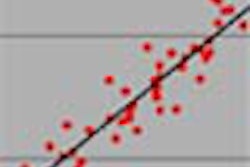VIENNA - Lower tube current is no problem, but thicker slices may distort the appearance of smaller polyps and inhibit their detection in virtual colonoscopy. These results, while preliminary, could have important implications for virtual colonoscopy providers seeking to maximize the exam’s sensitivity.
At today’s virtual colonoscopy sessions of the 2003 European Congress of Radiology, Dr. Johann Wessling from the University of Muenster in Germany discussed his group’s efforts to optimize the MDCT imaging protocol using a water-filled acrylic phantom filled with ersatz colonic polyps.
While single-slice CT protocols are largely standardized, no generally accepted guidelines have been set for multidetector-row CT, Wessling said. As a result, the minimum spatial resolution required for polyp detection must still be determined.
"One major concern in population-based screening is radiation exposure," Wessling said. "We know that the high contrast between the air-filled lumen and the colonic wall allows for substantial reduction of radiation exposure. The topic has received little attention so far, so the purpose of our study was to find the optimal detector collimation, slice thickness, and tube current for MDCT."
The group constructed an airtight, cylindrical air-filled phantom containing 9 "polyps" ranging from 2 to 12 mm in size, arranged in a crosshair pattern from small to large. The phantom was imaged on a four-row multidetector-row CT scanner using varying detector collimation (4 x 1 and 4.25 mm), and varying tube current of 10, 20, 40, 60, 80, 100 and 140 mAs. Varying slice-thickness and reconstruction-increment combinations included 1.25/0.6, 2/1, 3/1, and 5/3 mm.
Three experienced radiologists blinded to the acquisition parameters independently assessed polyp depiction and image degradation due to longitudinal distortion and the appearance of rippling artifacts on a four-point scale. They examined the images on a workstation using axial and 3-D reformatted endoluminal images, Wessling said.
"Endoluminal views show that longitudinal distortion results in artificial enlargement of polyps with blurred borders, a phenomenon that was mostly the result of higher mean slice thicknesses," he said. "We found sharp borders and good delineation even on small polyps using protocols with a slice thickness of 1.25 mm."
"Image degradation due to longitudinal distortion and rhythmic artifacts was most pronounced for slice thicknesses above 3 mm, but played a minor role in protocols with slice thicknesses below 3 mm," he continued.
So how does the protocol affect the detection of polyps? The detection of polyps ≥ 8 mm was independent of reduced slice thickness and detector collimation. However, the detection of polyps ≤ 6 mm may depend on the reconstruction slice thickness, and was always good with a slice thickness of 1.25 mm, Wessling said.
In endoluminal views, the depiction of small polyps was achieved at tube currents as low as 10 mAs, he said. Polyps 6 mm and smaller were generally not seen when detector the configuration was set to 2.5 mm.
Similarly, the detection of polyps ≥ 8 mm using 1-mm detector configuration and a slice thickness of 1.25 mm was independent of tube current reduction. And while the detection of smaller polyps deteriorates as tube current is lowered, it remains possible with currents as low as 10 mAs, he said.
With detector configuration set to 5 mm, the detection of large polyps was independent of tube current reduction, but again the detection of smaller polyps diminished as tube current was lowered, Wessling said.
"The effects of tube current reduction are much more evident for the 2.5-mm collimation as compared to the 1-mm configuration," he said. "And in fact this protocol failed to detect polyps at 10 mAs, and even at 140 mAs."
The results make narrow detector collimation and thin-slice imaging of 1.25 mm a prerequisite for low-dose virtual colonoscopy, Wessling concluded.
Following the talk, Dr. Riccardo Iannacone from the University of Rome commented that scattering effect might be lower in the water-filled phantom compared to results in patients, a potential study limitation that a University of Chicago group had once corrected by adding iodine to increase the attenuation of its water-filled phantom.
The results have important research implications, commented session moderator Dr. Andrea Laghi, also from the University of Rome. He added that tube current may need to be adjusted upward in some patients with larger body mass. Tube current of 10 mAs will certainly be possible with 16-slice scanners, Laghi said.
The phantom results coincide with the group’s experience in patients, Wessling said, and while small differences can be expected in the phantom results, the study could help explain the poor visualization of small polyps in many virtual colonoscopy studies.
Moreover, the potential radiation dose reduction seen as a result of increasing collimation from 1.25 to 2.5 mm is insignificant, on the order of 0.2 mSv or 10%-13% of the total exam dose, Wessling added.
Of course, considering that polyps smaller than 5 to 6 mm are nearly always clinically insignificant, even reporting them can be controversial.
By Eric Barnes
AuntMinnie.com staff writer
March 8, 2003
Related Reading
Waist size predicts optimal CT dose in virtual colonoscopy, February 7, 2003
Workflow issues key in virtual colonoscopy, January 15, 2003
Low-dose CT colonography accurately detects large colorectal neoplasms, July 30, 2002
Copyright © 2003 AuntMinnie.com




















